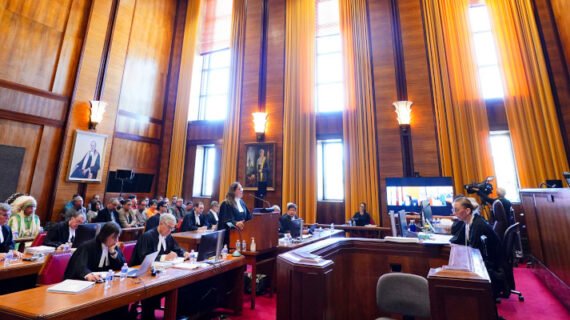Canadians are stressed about the economy. You don’t need mountains of polling data to figure that out. But dig into the work of Canada’s pollsters and you’ll find only 14 percent of people say they are better off financially than they were a year ago and, even worse than that, many Canadians don’t see any relief on the horizon. What can we do about this? In this five-part Hub series, we’re digging deeper into the economy, identifying our country’s fiscal problems, but also offering solutions to our monetary malaise.
Part 1: Independent or not, groupthink might be the Bank of Canada’s worst enemy

The economic history of Canada starts with beaver pelts, then dabbles in railroad construction and farming, and finally finds its way in the 20th century to a booming natural resource sector.
Are we now in the era of real estate?
In July, real estate and financial services combined to make up 20 percent of Canadian GDP, up from 16 percent in 1998.
A 2021 report released by Statistics Canada revealed that financial corporations contributed $102.7 billion to the economy in the fourth quarter of that year, $49.3 billion of which was mortgage and non-mortgage loans.
Martin Pelletier, the co-founder of TriVest Wealth, says there are consequences for real estate’s increased prominence in the Canadian economy.
“The problem with real estate is that it’s a non-producing asset,” says Pelletier. “There’s no continual compounding economic spinoff from that investment, so once it goes into real estate, that money’s gone.”
The Bank of Canada began raising interest rates last year to curb rising inflation, slowing down the ease at which mortgages were handed out by financial institutions, and thereby lowering demand and prices on the housing market.
Pelletier points out that most new jobs created in Canada during the last two years have been public sector jobs.
“We’ve gone all in on two areas, working for the government and real estate, and both of those are non-producing,” says Pelletier. “If you want to have economic growth, you’re going to have to redirect capital in some more productive areas of industry, and we’re just not seeing that in Canada.”
Canada’s economy has remained relatively stable for decades, but as in other advanced economies like Japan and the U.K., economic growth has remained sluggish compared to the U.S. and China.
We’ve gone all in on two areas, working for the government and real estate, and both of those are non-producing.
Martin Pelletier, co-founder of TriVest Wealth.
“When it comes to business sector investment, our investment levels have been flagging for a few years now, and that is actually also indicative of our productivity levels starting to diverge from other global economies,” says Trevin Stratton, Deloitte’s national economic advisory leader.
Finance is embedded across the world and within mixed and market economies. Client deposits placed in financial institutions, like retail banks, are pooled together and invested, together with other funds borrowed by the bank, into mortgages, startups, and other industries.
Wall Street’s top investment management companies like BlackRock, as well as the nearest drive-in payday loan outlet, are all technically part of the same financial services sector.
Last July, Statistics Canada updated its report on Canadian GDP by sector. Real estate, rental, and leasing topped the list with roughly $267 billion dollars in output, followed by manufacturing with $193 billion. Oil, gas, and mining accounted for $160 billion, while finance and insurance was worth $151 billion. On the whole, Canadian GDP was worth roughly $2 trillion last July.
By comparison in July of 1999, real estate accounted for $139 billion, while manufacturing stood at $193 billion. Oil, gas, and mining was worth $106 million, while $72 billion was bound up in finance and insurance.
Over the last nine years, the connection between investors and the real estate market in Canadian cities has deepened considerably, says Rob Aitken, an associate professor of political science at the University of Alberta.
“In parts of cities like Vancouver, their real estate market is not shaped much at all by the local market, or even domestic factors, it’s really an internationalized market shaped by the movements and interest and perceptions of investors,” says Aitken.
In 2020, investors were estimated to own one in four properties in Vancouver, and one in five in Toronto, largely financed by mortgages from commercial banks and investment firms.
“The financialization of the real estate sector…has changed the whole dynamic around home ownership as a route to middle-class equity and economic security,” says Aitken.
Canadian real estate’s stability as an asset makes it an attractive market for investors and prospective homeowners alike, who have enjoyed steady returns as house and condo prices have climbed across Canada for the last two decades. The average price of a house rose from $226,000 in 1999, to $339,030 in 2010, to about $640,479 to 2022.
Is real estate holding us back?
Pelletier says that, unlike real estate, natural resource development in areas like oil and gas continuously inject wealth into the Canadian economy. However Pelletier says recent regulations legislated by the federal government have hampered growth in that sector by turning off potential investors.
“We have something called Bill C-69 that puts heavy restrictions on any sort of infrastructure built out to support growth within the sector,” says Pelletier.
Bill C-69, the Impact Assessment Act and the Canadian Energy Regulator Act, was passed in 2019 and is aimed at changing the process by which Ottawa approves energy projects.
Every project is more difficult to do now than it was 20 years ago because of enhanced environmental scrutiny.
Lonzell Locklear, principal at Earnscliffe Strategies
Although C-69 does nominally streamline the approval process, it allows an indefinite number of resets in the planning stage. Other aspects of the bill include final decisions on energy projects being made by the federal minister of environment.
“The restrictions are so punitive that it essentially prevents any sort of project from being approved, and as a result, there is little appetite for capital being allocated in that direction,” says Pelletier.
Mining and other mineral extraction has also been hampered by growth in regulatory oversight, says Lonzell Locklear, a principal at Earnscliffe Strategies and former advisor on energy and environmental issues at the United States Embassy in Ottawa.
“In everything that I’ve heard, every project is more difficult to do now than it was 20 years ago because of enhanced environmental scrutiny,” says Locklear. “The challenge with mining is an additional challenge in that these (mines) are mostly set up in places that are really isolated.”
Consulting with Indigenous nations on land-use is another added process for getting mining projects approved, but Locklear says mining projects in remote areas need an enormous amount of infrastructure to be built which can be hampered by environmental assessments.
“At the end of the day, it’s the regulatory burden. This is something I heard for decades working for the U.S. government, is the regulatory burden in Canada for any project is much higher than it is for a similar project in the United States,” says Locklear.
Locklear says mining exploration is relatively straightforward, but getting large projects approved for extracting minerals like lithium mandates a large regulatory burden. Lithium is a considered a crucial mineral in the modern world for its use in rechargeable batteries for mobile phones and electric vehicles.
Several existing Canadian lithium mining companies have been sold to foreign entities in recent years, most notably the Neo Lithium Corporation, which was sold to a Chinese group to the outrage of the U.S. government.
“Canada needs to not only have extraction, but it needs to have processing and refining to capture the value add in the chain,” says Locklear. “If we’re just digging stuff up and sending it to someplace else, whether it’s the USA or to China, those jurisdictions are gaining all the value.”
The rise of financial services
Pelletier says that although financial services are well-regulated in Canada, it has grown faster as a sector of the economy due to increased restrictions on industries like on oil and gas, and that Canada’s economy is at risk of over-financialization.
“Having a healthy real estate market is good, we need to have a steady supply of houses from an affordability standpoint,” says Pelletier. “But from an economic growth standpoint, you’re better to see that money go into fueling and supporting industry and other areas.”
Aitken says that as the financial sector becomes a more significant part of the Canadian economy, the risks associated with it rise. Stratton agrees.
“It’s healthy when it comes to financial risk to have a diversified economy,” says Stratton.
After the American housing bubble collapsed in-large part due to defaults on subprime mortgages, the value of real estate plummeted, evaporating billions in invested money with global consequences as investors panicked. $14 trillion USD disappeared from the world’s economy in the fallout, made worse by the collapse of dozens of banks and other financial institutions, with millions in personal savings lost.
Canada has a stable currency, has a stable financial system, has a stable banking system, and has this reputation of being cautious and conservative.
Rob Aitken, associate professor of political science at the University of Alberta
Many of the institutions that collapsed during the subprime mortgage crisis were the product of mergers between retail banks, where average Americans deposit their paychecks, and previously pure investment management companies
Canada famously came out relatively unscathed after the Great Recession, due to a combination of pre-existing banking regulations and adroit coordination between the federal government and the Bank of Canada. Those regulations restricted subprime mortgage lending and prevented a crisis in Canada of similar proportions to the United States.
“We’ve seen a lot of upheaval in many countries, whether its financial markets or currency markets around the world,” says Aitken. “Canada has a stable currency, has a stable financial system, has a stable banking system, and has this reputation of being cautious and conservative (regarding finance).”
Much of Aitken’s research is dedicated to studying the financial sector, and its relationship to government and he says Bay Street’s proximity to the PMO is not nearly as intimate as that between Wall Street and the White House.
In Canada, Aitken says bankers are treated more traditionally and have not commonly ascended as high in the federal government. Nonetheless, many Canadian politicians take up well-paid finance jobs once they leave politics, presumably retaining their contacts within federal and provincial governments.
Protecting ‘mom and pop’ real estate investors
Despite the relative distance between Bay Street and Ottawa compared to other G7 countries, Mainstreet Research data analyst Robert Martin says the current Liberal government of Justin Trudeau has prioritized protecting real estate investors in recent years.
On February 2022, in response to calls to crack down on speculation from many Canadians unable to afford houses on the real estate market, Minister of Housing Ahmed Hussen announced the federal government did not want to harm “mom and pop” housing investors.
“I think a lot that’s basically indicative of what the government’s policies have been. The government’s policies have been to protect real estate speculators, instead of trying to get affordable homes for younger Canadians,” says Martin.
According to Martin, the federal government is mostly protecting people who already own homes and have moved into speculating on new assets.
Trevin Stratton explains that while financial services are often associated with the large banks, other organizations are also participants. Non-banks, such as private insurance companies like Sun Life Financial, will typically invest the premiums paid by their customers into long-term assets.
It is often referred to as “shadow banking” when non-banking financial institutions engage in investing client deposits, and the practice is not uncommon. Shadow banking on the whole is not subject to the same oversight as the main banking sector.

Although most of Canada’s largest investment firms remain retail and commercial banks, the shadow banking industry was estimated to have become a trillion dollar industry by 2016, half that of commercial banking at the time.
“That (shadow banking) in itself is an area that I would like to see some more regulation and some more transparency around because that could be a risk to the Canadian economy,” says Pelletier.
As to whether Canada’s economy is becoming over-financialized or not, Trevin Stratton says it depends.
“There are certain studies that if the financial services sector is too much of a contributor to the growth of an economy, then that might have impacts on productivity because investments might not necessarily be made in technologies and labour,” says Stratton.
As Canadian manufacturing and natural resources industries have been navigated new regulations over the last decade, Canada’s real estate and finance sectors enjoyed the Bank of Canada’s low rates. Borrowing money to finance mortgages could be accomplished with ease.
“The financial sector in general is the life blood of the economy in that when it’s healthy, it provides consumers and businesses with the things they need to grow, like credit,” says Stratton. “When the financial sector isn’t healthy…it can actually be the catalyst for a downturn in the rest of the economy.”




